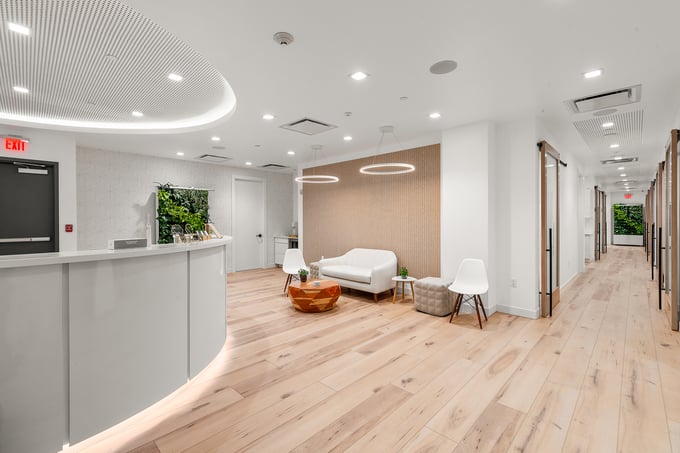In recent years, the trend of incorporating greenery into indoor spaces has gained popularity, with a growing demand for indoor greenwalls and house plants. This is not just for their aesthetic appeal, but also for the numerous health and wellness benefits that biophilic design offers.
Studies have continued to support the positive impact of biophilic design on overall wellness, and research in this area has been growing rapidly in the last decade. In this article, we will highlight four key ways in which biophilic design contributes to our well-being, supported by research studies.
- Plants in a medical office enhance attention, creativity, and productivity. In the article, “Biophilic design and office planting: a case study of effects on perceived health, well-being and performance metrics in the workplace,” by Nalise Hahn, Emmanuel Essah, and Tijana Blanusa, a study was conducted in a workplace environment. The study involved placing potted plants in individual offices and then removing them.
The results showed that the introduction of plants into offices had a positive impact on attention, creativity, and productivity, while their removal led to a negative impact on attention, productivity, stress, and efficiency. This study provides strong evidence for the benefits of changing the medical office environment to improve employee well-being and performance.

- The presence of natural elements in a medical office improves creativity and well-being. The 2015 Human Spaces Report, “The Global Impact of Biophilic Design in the Workplace,” studied the human response to biophilic design and the effects of biophilia on well-being. The study included 7,600 participants, all office workers, from 16 different countries.
The results showed that participants with natural elements in their work environments reported a 15% higher level of well-being, 6% higher level of productivity, and 15% higher level of creativity compared to those without natural elements. Workplaces with nature also had a positive effect on employee happiness and motivation. Furthermore, the presence of green in a medical office environment had a significant impact on workers' motivation, productivity, inspiration, happiness, creativity, and enthusiasm.
- Biophilic design leads to increased productivity and economic benefits. In addition to its positive impact on well-being, biophilic design also has economic benefits, as discussed in the article, "The Economics of Biophilia," by Terrapin Bright Green. The study found that elements of biophilia, such as plants in the workplace, increased employee productivity.
The report also stated that increased productivity resulted in economic benefits ranging from $1,000 per employee to $3.6 million company-wide. This research provides further support for the incorporation of biophilic elements in medical offices.
.png?width=680&height=381&name=lungs%20(1).png)
- Natural elements in medical offices improve organizational commitment and job satisfaction. In the article, “Why We Need More Nature at Work: Effects of Natural Elements and Sunlight on Employee Mental Health and Work Attitudes,” by Mihyang An, Stephen Colarelli, Kimberly O'Brien, and Melanie Boyajian, a study was conducted with 444 participants in the US and India.
The study found that an increase in natural elements, such as sun exposure and plants, resulted in higher organizational commitment and job satisfaction, as well as lower levels of depressed moods. This research supports the incorporation of living greenwalls in medical buildings for the benefits they provide to employees.
In conclusion, biophilic design has become a popular trend in recent years, and for good reason. The incorporation of natural elements, such as plants and green walls, into indoor spaces, has been shown to have numerous positive impacts on our well-being. Research studies have consistently supported the benefits of biophilic design, including increased attention, creativity, productivity, and overall employee well-being. Furthermore, incorporating biophilic design elements in medical offices can have economic benefits, such as increased productivity and organizational commitment. As we continue to learn more about the benefits of biophilic design, it is clear that integrating natural elements into indoor spaces should be a priority for creating healthy and productive work environments.


